

03/2004
2004 Accent on Architecture
Gala
AAF, AIA, and 1,000 friends celebrate design
excellence
 It’s
a tradition that architecture’s biggest “stars” shine
brightly at the American Architectural Foundation’s annual Accent
on Architecture: A Celebration of Design Excellence gala, set in the glorious
surround of Washington D.C.’s National Building Museum. However,
the first star on the gala’s horizon this year was smaller than
most—in stature, but certainly not in heart. Destiny Jackson, a
sixth-grade student from Germantown, Md., told the audience of more than
1,000 people in no uncertain terms, “Some of our schools are so
bad, they’re scary. And, if what we do in school is so important,
shouldn’t the buildings be important, too?”
It’s
a tradition that architecture’s biggest “stars” shine
brightly at the American Architectural Foundation’s annual Accent
on Architecture: A Celebration of Design Excellence gala, set in the glorious
surround of Washington D.C.’s National Building Museum. However,
the first star on the gala’s horizon this year was smaller than
most—in stature, but certainly not in heart. Destiny Jackson, a
sixth-grade student from Germantown, Md., told the audience of more than
1,000 people in no uncertain terms, “Some of our schools are so
bad, they’re scary. And, if what we do in school is so important,
shouldn’t the buildings be important, too?”
Destiny’s speech on the evening of March 3 at the 15th annual Accent on Architecture gala provided a perfect launch into a video explaining the AAF’s new initiative, “Great Schools by Design,” which emphasizes schools as centers for community, as well as centers for learning. Ronald E. Bogle, president and chief executive officer of the AAF, explained that the new initiative is a “collaborative response that promotes citizen engagement in the design process” to renovate thousands of schools, plus construct thousands of new schools over the next decade. Bogle also announced renewed effort on the AAF’s K–12 design education program, including development of a national forum on the subject that will be held in conjunction with the AIA’s national convention in Chicago on June 9.
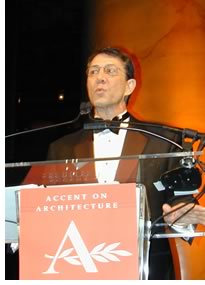 Bogle
then introduced Harold L. Adams, FAIA, RIBA, JIA, chair of the AAF Board
of Regents, who welcomed the architects, associates, and friends gathered
to honor this year’s Keystone Award, Architecture Firm Award, Twenty-five
Year Award, and Gold Medal recipients. “The Foundation’s programs
reflect the core belief that architecture should never be separated from
the people it serves,” Adams observed. He praised the efforts of
Bogle and “the great team he has assembled” over the past
year, and said simply, “I have always found Accent on Architecture
to be an inspirational experience, and I hope you do, too.”
Bogle
then introduced Harold L. Adams, FAIA, RIBA, JIA, chair of the AAF Board
of Regents, who welcomed the architects, associates, and friends gathered
to honor this year’s Keystone Award, Architecture Firm Award, Twenty-five
Year Award, and Gold Medal recipients. “The Foundation’s programs
reflect the core belief that architecture should never be separated from
the people it serves,” Adams observed. He praised the efforts of
Bogle and “the great team he has assembled” over the past
year, and said simply, “I have always found Accent on Architecture
to be an inspirational experience, and I hope you do, too.”
AIA President Eugene C. Hopkins, FAIA, marked the evening as a time to “celebrate magnificent architecture and some strong people as well.” AIA Executive Vice President/CEO Norman L. Koonce, FAIA, added his kudos to the AAF for the longevity and success of the 15-year-old Accent on Architecture program, and the synergistic relationship between the AIA and the AAF. “We share the responsibility to explore the power of architecture to enrich the human experience,” Koonce concluded.
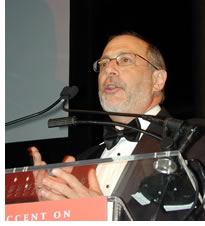 Awards
and accolades
Awards
and accolades
Robert Siegel, host of National Public Radio’s All
Things Considered, provided the “color” commentary
for the awards portion of the program. He drew unanimous concurrence from
the audience when he proclaimed the evening “a wonderful opportunity
to focus for one night on the good, the true, and the beautiful.”
Keystone Award
Adams presented the Office of the Commissioner of the Public Buildings
Service, U.S. General Services Administration (GSA), with the 2004
AAF Keystone Award, created in 1998 to recognize outstanding design
leadership from outside of the design professions, and is honoring GSA
for exceptional leadership through its Design Excellence Program. Public
Buildings Service Commissioner F. Joseph Moravec and former commissioner
Robert A. Peck, Hon. AIA, accepted the award on behalf of the office.
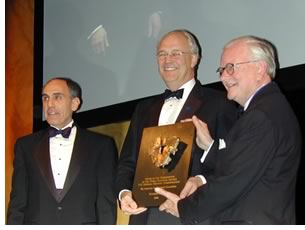 “If
design excellence was good enough for Washington and Jefferson, and for
the first 150 years of this country’s history, it should be good
enough for us,” Peck declared. He reminded the audience that “we
need to remember that design excellence in public buildings is not inevitable,”
and that “it is not a partisan issue, but rather reflects shared
values.” Moravec in turn thanked the AAF for its “steadfast
support of the Public Buildings Service and for this extremely important
honor.”
“If
design excellence was good enough for Washington and Jefferson, and for
the first 150 years of this country’s history, it should be good
enough for us,” Peck declared. He reminded the audience that “we
need to remember that design excellence in public buildings is not inevitable,”
and that “it is not a partisan issue, but rather reflects shared
values.” Moravec in turn thanked the AAF for its “steadfast
support of the Public Buildings Service and for this extremely important
honor.”
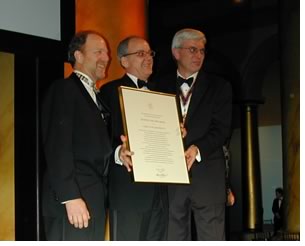 Architecture
Firm Award
Architecture
Firm Award
Siegel pronounced the architectural process “a complex dance,”
and praised the choreography of Lake|Flato Architects Inc., San Antonio,
the recipients of the 2004
AIA Architecture Firm Award. Hopkins presented the citation to partners
David Lake, FAIA, and Ted Flato, FAIA. It represents the highest honor
the AIA bestows on an architecture firm, and it recognizes a practice
that has consistently produced distinguished architecture for at least
10 years.
“It has been a long journey from just the two of us to a family of 50,” said Flato, who asked the entire Lake|Flato staff to stand and be recognized. He said that he and Lake came to the realization just recently that “our greatest accomplishment was not a single work or a body of work. It’s our staff.” Lake in turn described the firm’s beliefs of what architecture should be, including “true to place,” and described the gratification of seeing the firm’s name carved in granite on the Firm Award wall in the AIA headquarters building.
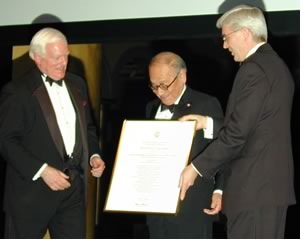 Twenty-Five
Year Award
Twenty-Five
Year Award
The East Building of the National Gallery of Art, designed by New York
City’s I.M. Pei & Partners, Architects, received the AIA
Twenty-Five Year Award, honoring significant architectural landmarks
completed 25–35 years ago that have withstood the test of time.
The venerable I.M. Pei, FAIA, RIBA, and Earl A. Powell III, director of
the National Gallery, accepted the award from President Hopkins on behalf
of the building, which clearly was a favorite of the audience.
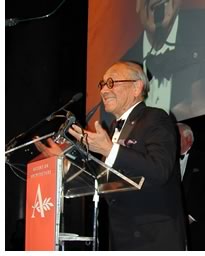 “I
consider this to be the most important award I ever received as an architect,”
Pei said. “I am lucky; 25 years is a long time.” The architect
recalled the eight-year (1970–78) period during which the East Building
was under construction, and the enormous contributions to the process
by many architects who worked on the project. “I think I’ve
produced enough architecture to say this to you,” Pei confided.
“To produce good architecture, you need a good client.” He
paid homage to Powell; the late Paul Mellon, former director of the gallery;
the late J. Carter Brown, Hon. AIA, former director and chair of the Commission
of Fine Arts; and John Russell Pope, architect of the gallery’s
West Building. Pei concluded by acknowledging that he enjoys visiting
the East Building, not for the architecture, but “to look at the
people.”
“I
consider this to be the most important award I ever received as an architect,”
Pei said. “I am lucky; 25 years is a long time.” The architect
recalled the eight-year (1970–78) period during which the East Building
was under construction, and the enormous contributions to the process
by many architects who worked on the project. “I think I’ve
produced enough architecture to say this to you,” Pei confided.
“To produce good architecture, you need a good client.” He
paid homage to Powell; the late Paul Mellon, former director of the gallery;
the late J. Carter Brown, Hon. AIA, former director and chair of the Commission
of Fine Arts; and John Russell Pope, architect of the gallery’s
West Building. Pei concluded by acknowledging that he enjoys visiting
the East Building, not for the architecture, but “to look at the
people.”
Powell thanked the AIA for the honor, and quipped, “We’ll get another 25 years out of this building—if you quit touching it!” referring to Siegel’s earlier observation concerning the East Building’s famous knife-edge wall that architects—and the general public—can’t seem to keep their hands off.
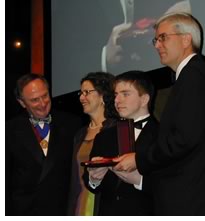 Gold
Medal
Gold
Medal
In December, the AIA Board selected Samuel Mockbee, FAIA (1944–2001)
to receive the 2004
AIA Gold Medal posthumously. The highest honor the AIA confers to
an individual, the Gold Medal recognizes an individual whose significant
body of work has had a lasting influence on the theory and practice of
architecture. Hopkins and Koonce presented the 60th Gold Medal to Mockbee’s
widow, Jackie Mockbee, Assoc. AIA, and their son, Julius. Hopkins praised
Mockbee’s “dedication to architecture’s effect on the
human spirit. We honor a true inspiration to this profession.”
“Sambo would have been honored to share this evening with Lake|Flato and I.M. Pei,” Jackie Mockbee told the audience. “Sambo worked a long, long time to achieve what he achieved.” She told the audience that he had decided at age 6 to become an architect and “he promised himself that he would make great architecture.”
Jackie Mockbee introduced their three daughters and son, then remarked upon her late husband’s wonderful rapport with their children and all the children in the neighborhood. “He never said, ‘I’m tired,’ or ‘not now,’” she told the audience. “We know what meant the most to Sambo—our children and I.” The audience concluded the program with a standing ovation to honor the generous spirit of a departed colleague as well as the brave architectural legacy and the family that remain.
Copyright 2004 The American Institute of Architects.
All rights reserved. Home Page ![]()
![]()
 |
||
| Photos by Douglas E. Gordon, Hon. AIA The American Architectural Foundation thanks the following for their generous support of the 2004 Accent on Architecture gala: • Principal Benefactor: McGraw-Hill Construction
|
||